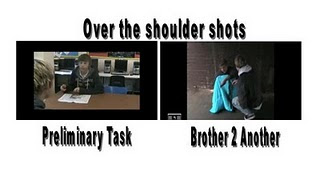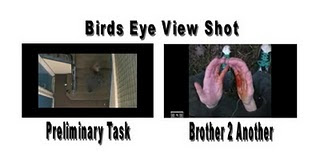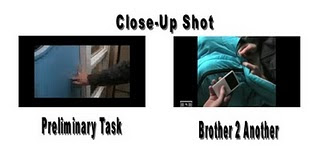Below is our preliminary task (continuity editing task);
Looking back at our preliminary task it is clear that we have progressed alot and improved/ expanded our knowledge, as a group this was our first time we had ever filmed and edited properly. We used very basic skills which we have now built on for our Opening Two Minutes only using the 180 degree rule, match on action, shot/reverse shot and high and low angles, whereas now we have expanded to nearly all types of camera angles and shots.
Editing has improved a huge amount also throughout the two tasks, starting with very basic continuity transitions, then into fade in, fade out, creative, fast and slow paced editing to create a mood in which the audience will enjoy or find beneficial whilst watching.

As you can see above, both Over the Shoulder Shots are quite different, one from a level angle (basic) and the other slightly more creative and thought up to prove effective when representing social class.
The 180 degree rule is also an important rule you must consider when filming, if you film from the other side of this are the audience will be off put and likely to be dis-orientated. We had to be very careful when filming a conversation in both films as it is easy to step over this line without realising, resulting in a messy confusing scene, likely to put the viewer off.

In the screen grabs above you are able to see the difference and progress we have generally made on the creativity and thoughts behind the shots, using the birds eye view shot or in 'Brother 2 Another' a point of view shot, these both work in similar ways, a birds eye view shot helps the audience to get a general over view on what/where the character is doing/going, in this case going up the stairs. Whereas in 'Brother 2 Another' the point of view shot was used to allow the audience almost see the world through the characters eyes, in this case, experiencing, pain, shock and fright from the mugging, also helping the audience to feel involved in the story.

Close-ups are one of the standard shots used regularly with medium shots and long shots. Close-ups display the most detail, but they do not include the broader scene.
Close-ups are used in many ways, for many reasons. Close-ups are often used as cutaways from a more distant shot to show detail, such as characters' emotions, or some intricate activity with their hands. In this case an in depth sense of shock is made by the shot to highlight the issue of a brutal attack.
No comments:
Post a Comment